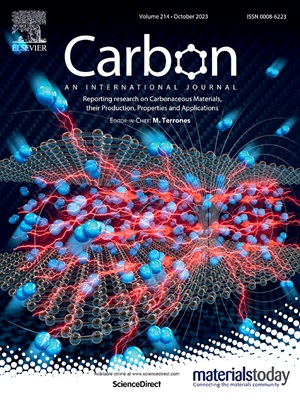Multifunctional nitrogen-doped graphene quantum dots enables efficient and stable GaAs/CNT heterojunctions solar cell
IF 11.6
2区 材料科学
Q1 CHEMISTRY, PHYSICAL
引用次数: 0
Abstract
GaAs heterojunction solar cells (HJSC) have attracted a lot of attention because of their potential affordability and wide range of future military and commercial uses. However, non-radiative recombination and inadequate spectrum absorption impede further performance improvement. Therefore, in this paper, a GaAs/carbon nanotube (CNT) HJSC modified by Nitrogen-doped graphene quantum dots (N-GQDs) is designed. Under standard AM1.5G illumination, the photoelectric conversion characteristics of the device were analyzed by the current density-voltage (J-V) curve and an external quantum efficiency (EQE) spectroscopy measurement system. The photovoltaic conversion efficiency (PCE) reached 15.01 % from the initial 11.87 %, and the efficiency reaches 16.53 % after using WO3 thin film as Anti-reflective layer (ARC). Furthermore, it is shown by Raman spectroscopy (Raman), photoluminescence spectroscopy (PL), scanning electron microscopy (SEM) system, etc, the introduction of N-GQDs can inhibit the recombination of interfacial carriers, improve the Schottky barrier of heterojunction, and convert ultraviolet light into visible light. In this way, Broaden the utilization range of the solar energy spectrum and promote the effective separation of carriers. The battery system demonstrates excellent stability in the air for one month. This work demonstrates an encouraging high-performance, low-cost, air-stable solar cell optimization.

多功能氮掺杂石墨烯量子点实现了高效稳定的GaAs/CNT异质结太阳能电池
砷化镓异质结太阳能电池(HJSC)由于其潜在的可负担性和广泛的未来军事和商业用途而引起了人们的广泛关注。然而,非辐射复合和光谱吸收不足阻碍了性能的进一步提高。因此,本文设计了一种氮掺杂石墨烯量子点(N-GQDs)修饰的GaAs/碳纳米管(CNT) HJSC。在标准AM1.5G照明下,通过电流密度-电压(J-V)曲线和外量子效率(EQE)光谱测量系统分析了器件的光电转换特性。光电转换效率(PCE)由初始的11.87%提高到15.01%,采用WO3薄膜作为抗反射层(ARC)后效率达到16.53%。此外,通过拉曼光谱(Raman)、光致发光光谱(PL)、扫描电镜(SEM)等系统研究表明,N-GQDs的引入可以抑制界面载流子的重组,提高异质结的肖特基势垒,将紫外光转化为可见光。这样拓宽了太阳能光谱的利用范围,促进了载流子的有效分离。电池系统在空气中表现出一个月的优异稳定性。这项工作展示了一个令人鼓舞的高性能、低成本、空气稳定的太阳能电池优化。
本文章由计算机程序翻译,如有差异,请以英文原文为准。
求助全文
约1分钟内获得全文
求助全文
来源期刊

Carbon
工程技术-材料科学:综合
CiteScore
20.80
自引率
7.30%
发文量
0
审稿时长
23 days
期刊介绍:
The journal Carbon is an international multidisciplinary forum for communicating scientific advances in the field of carbon materials. It reports new findings related to the formation, structure, properties, behaviors, and technological applications of carbons. Carbons are a broad class of ordered or disordered solid phases composed primarily of elemental carbon, including but not limited to carbon black, carbon fibers and filaments, carbon nanotubes, diamond and diamond-like carbon, fullerenes, glassy carbon, graphite, graphene, graphene-oxide, porous carbons, pyrolytic carbon, and other sp2 and non-sp2 hybridized carbon systems. Carbon is the companion title to the open access journal Carbon Trends. Relevant application areas for carbon materials include biology and medicine, catalysis, electronic, optoelectronic, spintronic, high-frequency, and photonic devices, energy storage and conversion systems, environmental applications and water treatment, smart materials and systems, and structural and thermal applications.
 求助内容:
求助内容: 应助结果提醒方式:
应助结果提醒方式:


